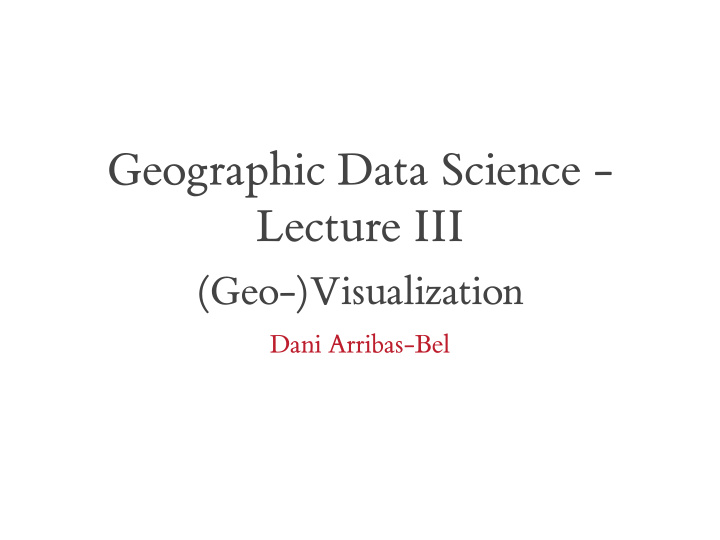



Geographic Data Science - Lecture III (Geo-)Visualization Dani Arribas-Bel
Today Visualization What and why History Examples Geovisualization What “A map for everyone” Dangers of geovisualization
Visualization
“Data graphics visually display measured quantities visually display measured quantities by means of the combined use combined use of points, lines, a coordinate system, numbers, symbols, words, shading, and color.” The Visual Display of Quantitative Information . Edward R. Tufte.
[ Source ]
A bit of history Maps –> Data Maps (XVIIth.C.) –> Time series (1786) –> Scatter plots Surprisingly recent: 1750-1800 approx. (much later than many other advances in math and stats!) William Playfair ’s “linear arithmetic” : encode/replace numbers in tables into visual representations. Other relevant names throughout history: Lambert, Minard, Marey.
Visualization The Visual Display of Quantitative Information . Edward R. Tufte. By encoding information visually , they allow to present large amounts of numbers in a meaninful way. If well made, visualizations provide leads into the processes underlying the graphic.
Historical examples [ ] XVIIIth. Cent. - Pytometrie [ ] Playfair’s bar chart in The Source Source by J. H Lambert Commercial and Political Atlas (1786) [ ] Lambert - Evaporation rate Minard - Napoleon army map (XIXth. Source Cent.) against temperature, 1769
Geo visualization
Tufte (1983) “The most extensive data maps […] place millions of bits of information on a single page before our eyes. No other method for the display of statistical information is so powerful”
MacEachren (1994) “Geographic visualization Geographic visualization can be defined as the use of concrete visual representations –whether on paper or through computer displays or other media–to make spatial make spatial contexts and problems visible contexts and problems visible, so as to engage the most powerful human information processing human information processing abilities, those associated with vision.”
GeoVisualization End goal is not to replace the human in the loop , but to augment her/him. Augmentation here comes through engaging the pattern recognition capabilities that our brain inherently has. Combines: Traditional maps Statistical maps Statistical devices of other kind (charts, scatter plots, etc.) Different roles in the analysis process…
A map for everyone Maps can fulfill several needs Depending on which one we want to stress, the best map will look very different MacEachren & Kraak (1997) identify three main dimensions: Knowledge of what is being plotted Target audience Degree of interactivity
MacEachren & Kraak (1997) map cube [ Source ]
Un/known: fast and slow maps
Fast maps [ Source ]
Slow maps [ Source ]
Audience: easy and hard maps
Easy map [ Source ] Map of same-sex marriage in the US, 2015
Hard map [ Source ]
Interaction: one or many maps in one
Static map
Interactive map Indicators CDRC Data NRDF Maps & Stories + 1000 m OAC 2011 MAP KEY − CDRC Maps 2011 OAC OAC OAC 2001 2011 The Area Classi fi cation of Output DATA CHOOSER Areas (OAC) 2011. Geodem Indicators Metrics More info about this map Download these data Select a map: 2011 Area Classif/n of OAs Rural Residents Cosmopolitans This website uses cookies to ensure you get MAP OPTIONS Ethnicity Central the best experience on our website. Land Labels Multicultural Metropolitans Layers: Learn more Pin Clear Overlays: Urbanites Like 343 Tip: Try dropping KML or Share Got it! Suburbanites GeoJSON fi les onto map. Important note: Classifications are an average across the Go local area, rather than for individual houses, therefore the Constrained City Dwellers Postcode: colour coding on a building is not necessarily indicative of About/Attribution that building. Hard-Pressed Living
Dangers of GeoVisualization
How to lie with maps
How to lie with maps The human brain is so good a picking up patterns… … that it finds them even where they don’t exist! Patternicity (Shermer, 2008) The tendency to find meaningful patterns in meaningless noise Apophenia (Konrad, 1958) The experience of seeing patterns or connections in random or meaningless data
Twitter clusters
How to be truthful with maps “With great power comes great responsibility” Statistics to the rescue!!! Complement and enhance visuals Help disentangling true from spurious patterns (a.k.a. identifying the “Jesus on the toast”) Reciprocity : GeoVis can also enhance statistics and make them more useful
Statistics for Twitter clusters
Recapitulation Visualization of statistical data is a fairly recent phenomenon. Its power comes from engaging and augmenting the human in the loop, rather than replacing her/him. Its power can be misused , but there are methods to limit this risk.
Geographic Data Science’18 by Dani Arribas-Bel is licensed under a Creative Commons Attribution- ShareAlike 4.0 International License .
Recommend
More recommend